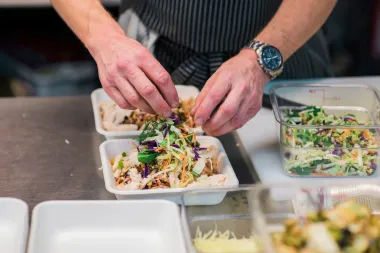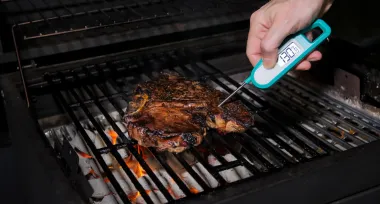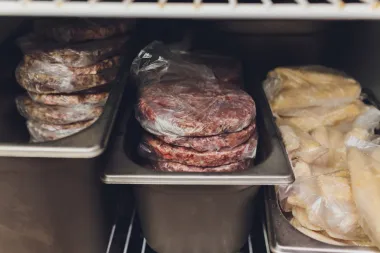
Food safety, hygiene and cleanliness underpin the success of any restaurant brand. And a food safety management system can help you stay on top of this critical area of restaurant management.
Food safety is an unglamorous job involving keeping the restaurant floor, kitchen and storage areas clean, storing and preparing food safely and documenting every effort to prevent a food safety issue.
With all the other stresses and strains of running a restaurant, it’s vital not to let food hygiene standards slip. But it's easier said than done. That’s where a food safety management system can help.
Putting a plan in place to mitigate the risks of a food safety issue keeps your customers safe and protects you from potential legal problems. A digital food safety management system automates much of the tedious work and helps to keep your team engaged in food safety procedures every day.
Let’s take a closer look at what a food safety management system is and how it can help you run a more efficient, profitable and controversy-free restaurant.
What is a food safety management system?
There are a couple of different ways to answer this question. The broader sense of a food safety management system is a plan put in place to minimise the risks associated with food preparation and storage.

But a digital food safety management system can also mean a computer system with tools and features to help you manage food safety and hygiene.
Let’s look at both in turn.
Definition of food safety management system
A food safety management system helps you take a proactive and preventative approach to food safety. Rather than reacting to a problem after the damage is already done, you identify any risks and then put a plan in place to mitigate them.
One of the most common systems used is a HAACP analysis and plan. HACCP stands for Hazard Analysis and Critical Control Points. It is a food safety management system that helps to identify and prevent potential food safety hazards in the food production process.
A HACCP plan is a written document that outlines the procedures and processes that a food business has in place to ensure that the food it produces is safe for consumption. The plan typically includes the following steps:
Conducting a hazard analysis to identify potential physical, biological and chemical hazards at each stage of the food production process.
Determining the critical control points (CCPs) where these hazards can be controlled or prevented.
Establishing critical limits for each CCP to ensure that the hazards are effectively controlled.
Implementing monitoring procedures to ensure that the critical limits are met.
Establishing corrective action procedures to be taken if the critical limits are not met.
Implementing verification procedures to confirm that the HACCP system is working effectively.
Keeping records to document the HACCP system and to demonstrate compliance with food safety regulations.
The goal of a HACCP plan is to prevent food safety hazards from occurring, rather than waiting for a customer to get ill first.
What is a digital food safety management system?
A digital food safety management system is a piece of software with all the tools you need to manage food safety and hygiene at a restaurant.
It includes features like digital cleaning checklists, automatic temperature monitoring and document storage to help you stay on top of food safety and meet any regulatory requirements.
A modern cloud-based POS system, or restaurant management system, often has these features built-in, so you can easily access your health and food safety tools and documentation from one system wherever you are.
The purpose of food safety management systems
Food safety management systems are a critical component of any food industry operation, whether you're a chain of restaurants or an independent takeaway. The purpose of a food safety management system is to ensure that the food products you produce, prepare and serve are safe for consumption, free from contamination and meet the required safety standards.
In this section, we'll look at the reasons why it’s so important to implement a food safety management system.
Make sure food safety standards are adhered to
One of the primary objectives of a food safety management system is to ensure that all food safety standards are adhered to at all times.
A food safety management system helps you to identify and control any potential hazards in the food production process, from raw materials to finished products, so that you can be confident that the food you serve is safe for consumption.
Comply with regulations
Having a food safety management system in place also helps you to comply with all relevant food safety regulations, which can vary depending on the country or region in which you operate.
By following a food safety management system, you can demonstrate your commitment to food safety and reduce the risk of regulatory penalties or legal action in the event of a food safety breach.

Avoid a foodborne disease outbreak
Foodborne illness outbreaks can have devastating consequences, not just for those affected but also for your restaurant’s reputation. A food safety management system minimises the risk of a foodborne disease outbreak occurring, as you will have identified and controlled any potential hazards in the food production process.
Get a 5 star food hygiene rating
Finally, having a food safety management system in place can also help you to achieve a 5 star food hygiene rating, which is the recognised standard of food safety.
A 5 star rating demonstrates your commitment to food safety and can help you to win new business and retain existing customers. It also serves as a reassurance to your customers that the food you produce, prepare and serve is of the highest quality and safe for consumption.
Benefits of a food safety management system
We’ve discussed the reasons for implementing a food safety management system, which are mainly about preventing negative consequences.
Now let’s look at the positives and discuss the potential benefits of a proper food safety management system.
Minimise the risk of a disastrous event
It’s not just foodborne illness that restaurant owners have to worry about, although that in itself could spell the end of your restaurant. A food safety management system could also prevent an equipment failure, an infestation of vermin or a negative report, or even a shutdown order, from your health and food safety inspector.
A proper system helps minimise the risk of one of these catastrophic events occurring.
Easy compliance with regulations
Another benefit of a food safety management system is that it helps you to comply with all relevant food safety regulations. By following a food safety management system, you can demonstrate your commitment to food safety and reduce the risk of regulatory penalties or legal action in the event of a food safety breach.
With all your documentation accurate, up to date and stored digitally, all you have to do is show the inspector your digital records and he’ll be happy. For the health inspector, it’s far easier to offer a 5 star food hygiene rating when all the records are stored immaculately online, rather than in neglected grease-stained notebooks.
Increased customer confidence
A well-implemented food safety management system can also help to increase customer confidence in the food you serve. By demonstrating your commitment to food safety and quality, you can win new business and retain existing customers, helping to build and maintain a strong reputation for your restaurant.
Improve employee training
A food safety management system can help to boost employee engagement and improve training by providing a centralised platform for storing and delivering food safety training materials.
Digital checklists are far more likely to be used day in and day out as ticking off the jobs is more like playing a game than simply filling out a paper form.
A digital system that tracks training progress ensures that all employees receive consistent training and understand their role in maintaining the food safety management system, reducing the risk of food safety breaches happening in the first place.
Save time
With a food safety management system, you can automate many food safety processes, such as monitoring, reporting and record-keeping. This can help to streamline your food safety management and reduce the time and resources you need to allocate to these tasks.
A centralised platform also makes it easier to access and share food safety information, helping to speed up the resolution of food safety issues and reducing the risk of food safety breaches. With all that time saved, you and your team can focus on other areas of your business, such as improving customer service and working on new and improved dishes.
Save money
A food safety management system built into your POS is not only cheap and easy to implement, it has the potential to save you thousands.
By reducing the risk of foodborne illness outbreaks and helping you comply with food safety regulations, a food safety management system can minimise the risk of legal action and penalties, which can be costly.
But it also offers day-to-day savings:
Easy-to-use checklists reduce the cost of training new staff on cleaning and food safety procedures
Restaurant food safety fridge storage best practices reduce the amount of food lost to spoilage
Improving customer confidence and building a reputation increases revenue through better loyalty
Features of a digital food safety management system
A digital food safety monitoring system simplifies every aspect of food safety management. A range of features help to automate tasks, improve staff training and engagement and provide critical reminders and alerts.
Here are the common features to look out for:
Digital food temperature logging
Cooking temperatures are one of the most important control points in any HACCP plan. Undercooked meat carries a risk of food poisoning so most food safety regulations lay out minimum internal temperatures for meat and fish.

These temperatures need to be logged to demonstrate compliance with the rules and for busy chefs, noting down temperatures in a notebook is impractical and tedious. Much of the time, kitchen workers end up “pencil whipping” lists of temperatures, which basically means making them up at the end of the day to satisfy the regs.
With a digital system, temperatures can be easily logged on a touchscreen device, or even better, automatically logged with a digital thermometer connected to the system.
Digital appliance temperature monitoring
Fridge and freezer temperatures must stay within a safe temperature range to ensure food is stored safely and minimise the risk of spoilage. That’s why HACCP plans require you to take temperature readings for all your devices throughout each day.
If a freezer breaks down overnight, you could have an expensive mess on your hands, so temperature monitoring is very important. But 99.9% of the time, the temperatures will be well within the safe range. So again, kitchen staff can get complacent and skip the required steps.
Digital temperature monitoring connected to a food safety management system automates the entire process. Fridge and freezer temperatures are constantly monitored and you are alerted as soon as the temperature goes outside the safe range.
This saves your staff time, ensures you are complying with recording requirements and could save thousands in spoiled ingredients.
Appliance service recording
A digital food safety management system can also store records of service and maintenance of your appliances to minimise the risk of a breakdown. The system can be programmed to send potential hazard alerts so you know if any issues arise before they become bigger problems.
Easy access to documentation
All your temperature and maintenance records, cleaning schedules and food safety plans are stored safely in the cloud and kept up to date.
This gives you clarity and visibility over the standards you are keeping and makes it much easier to perform a food safety audit. It also means that when the health inspector pays a surprise visit, you don’t have to worry. You can easily locate the required documents and have them ready for inspection.
Digital cleaning and opening/closing checklists
Digital checklists ensure staff know exactly what needs to be checked and cleaned each day, at opening, closing and during the day. Staff tend to be more engaged with a digital checklist than with a paper list. They can tick off items as they go and get a running percentage of completion.
As a manager or store owner, a digital system allows you to monitor completion rates and compare performance across stores to see which teams are completing their checklists each day. This can be used to make daily chores into a competitive game, which further helps to engage staff in the activity.
Who is responsible for implementing food safety management systems?
As an operator of a restaurant, it is your responsibility to ensure that a food safety management system is in place and properly implemented.

It is your responsibility to ensure that all employees are trained in the principles of food safety and understand their roles in maintaining the restaurant's standards. You should also appoint a person or team to be responsible for overseeing the implementation and ongoing monitoring of the food safety management system, and for ensuring that it is regularly reviewed and updated as necessary.
By taking these steps, you can demonstrate your commitment to food safety and always provide your customers with safe, high-quality food.
Protect your restaurant with a robust food safety management system
A food safety management system is a framework for minimising risks in your restaurant and a digital system makes the whole process a lot easier for you and your team.
Not only does a well-managed system mitigate the risk of a serious food safety event, but on a day-to-day level, it can save the business money, keep staff more engaged and help maintain your excellent reputation.
It’s probably easier than you think to get access to the latest tools like digital checklists, automatic temperature monitoring and customised safety alerts. All you need is the right cloud-based restaurant POS system.


